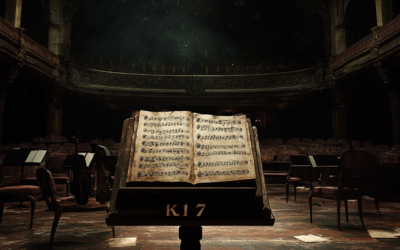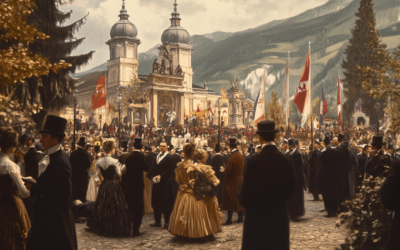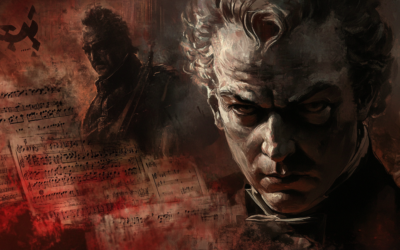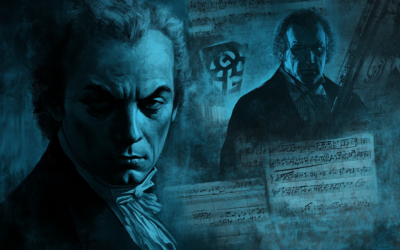K.6 and K.7 Sonatas
A Fabricated Genius?
The earliest sonatas of Wolfgang Amadeus Mozart, K.6 and K.7, are traditionally seen as proof of his precocious genius. But as we explore the murky origins of these works, we find that they may be more a product of Leopold Mozart’s ambition than Wolfgang’s musical talent. The truth, as always, lies somewhere between the notes.
Mozart: The Fall of the Gods
This book compiles the results of our studies on 18th-century music and Mozart, who has been revered for over two centuries as a deity. We dismantle the baseless cult of Mozart and strip away the clichés that falsely present him as a natural genius, revealing the contradictions in conventional biographies. In this work, divided into two parts, we identify and critically analyze several contradictory points in the vast Mozart bibliography. Each of the nearly 2,000 citations is meticulously sourced, allowing readers to verify the findings. This critical biography of Mozart emerges from these premises, addressing the numerous doubts raised by researchers.
"In the world of Mozart, nothing is quite as it seems—least of all his earliest sonatas."
Mozart: The Fall of the Gods
The two sonatas, K.6 and K.7, are often referred to as some of Mozart’s earliest compositions, allegedly written when he was just seven years old. This claim has been firmly entrenched in the narrative of his supposed genius, with Leopold Mozart diligently attributing these works to his young son in the first catalogue of his compositions. However, a closer look at the origins of these sonatas, and the circumstances surrounding their publication, raises significant doubts about their authenticity and who truly composed them.
The Origin of K.6 and K.7: A Family Affair?
The Sonata in C Major K.6, like its sibling K.7, is part of a set of sonatas for harpsichord with violin accompaniment, printed in 1764. According to Leopold, these pieces were composed by Wolfgang during their European travels, and he was eager to present his son as a young prodigy. However, as we dig into the details, we find that these sonatas may not be as original as Leopold wanted the world to believe.
It is well-documented that earlier keyboard pieces from Nannerl’s notebook, which predates Wolfgang’s supposed compositions, were used in the creation of these sonatas. These pieces were not composed by Wolfgang at all but were simply reworked or modified by Leopold. Interestingly, these earlier pieces exist only in Leopold’s handwriting, as no autographs by Wolfgang exist for these sonatas. Some musicologists have suggested that these could be improvisations by the young Mozart, but such claims are impossible to verify without a time machine.
Leopold’s Questionable Intentions
Leopold’s role in shaping his son’s early career is undeniable. He was determined to present Wolfgang as a musical genius from a very young age, and many contemporary sources were sceptical of his claims. For instance, during the period of La finta semplice, numerous critics accused Leopold of composing the works attributed to Wolfgang, believing that the father, not the child, was the true composer. The K.6 and K.7 sonatas appear to be part of this larger agenda.
On this site, we’ve previously discussed how Leopold manipulated the narrative surrounding key moments in Wolfgang’s early career, such as the exam in Bologna and Durosoy’s poem, showing a pattern of deceit and exaggeration. So, is it any surprise that the true authorship of these sonatas should be questioned as well?
The Problem with Nannerl’s Notebook
Looking at the musical material itself, the second Minuet from K.6, for example, was allegedly composed on 16 July 1762, while other movements were supposedly written in various cities during the Mozarts’ European tour. Yet, there are no definitive signs pointing to Wolfgang’s authorship for some of these movements. Notably, they are absent from the musical supplement to Nissen’s Mozart biography of 1828, which only includes the dated compositions from Nannerl’s notebook known to be Wolfgang’s.
Curiously, the only two pieces in Nannerl’s notebook that seem to show Wolfgang’s handwriting were never used in these sonatas. Wolfgang Plath, a renowned Mozart scholar, believed this to be the case, although his methods were far from rigorous. His analysis, based on subjective handwriting characteristics, lacks the scientific foundation necessary for such a claim.
The Hypothesis of Wyzewa and Saint-Foix
One hypothesis, proposed by Théodore de Wyzewa and Georges de Saint-Foix, suggests that KV 5a was originally intended as the Finale for K.6. However, this idea seems far-fetched. KV 5a bears more resemblance to a first movement, and the timeline for its composition doesn’t align with that of K.6. Furthermore, there’s no certainty that the remaining movements of the sonatas were even written in December 1763 and January 1764, as Leopold claimed.
A Grand Illusion in Paris
In March 1764, Leopold took the ambitious step of having the sonatas printed in Paris at his own expense. The title of the printed sonatas reads as follows:
Sonates / Pour Le Clavecin / Qui peuvent se jouer avec l’Accompagnement de Violon / Dediées / A Madame Victoire / De France / Par J. G. Wolfgang Mozart de Salzbourg / Agé de Sept ans. / Oeuvre Premiere. / Prix 4L 4S / Gravées par Mme Vendôme Ci-devant rue St. Jacques / à present rue St. Honoré Vis-à-vis le Palais Royal. / A Paris / aux adresses ordinaires / Avec Privilege Du Roi.
The dedication to Madame Victoire, the second daughter of King Louis XV, is highly suspicious. It was most likely fabricated by Melchior Grimm, a key figure in the Mozarts’ Paris connections, to boost the sale of the sonatas. The supposed letter from Wolfgang, written in obsequious tones to Madame Victoire, reeks of Leopold’s hand. It is difficult to believe that such a sophisticated and strategically flattering dedication came from a seven-year-old child.
Conclusion: A Manufactured Legacy
The sonatas K.6 and K.7 may hold an esteemed place in the Mozart mythos, but the evidence points to a far more complex and questionable origin. Between Leopold’s manipulations and the dubious use of earlier keyboard pieces from Nannerl’s notebook, these sonatas seem to have been more about marketing a child prodigy than about true musical innovation. As we continue to unearth the truth behind Mozart’s early works, it becomes increasingly clear that Leopold’s ambitions played a much larger role in shaping his son’s legacy than history has been willing to admit.
You May Also Like
Constanze Mozart’s Enduring Love
Although some have doubted her devotion, Constanze’s own words and actions illustrate a widow deeply committed to preserving Mozart’s legacy. Diaries, personal correspondence, and eyewitness testimony all challenge the notion that she neglected his memory—while the circumstances around his burial grow ever more perplexing.
A Revealing New Interview on His Thematic Catalogue
We’re excited to present a brand-new interview that challenges many of the long-held assumptions about Mozart’s Thematic Catalogue (1784–1791). Conducted by Swedish journalist Henry Grynnsten, this conversation delves into groundbreaking forensic techniques—like advanced ink analysis and digital image processing—that may change the way we view Mozart’s late works.
The Rattling Symphony: A Critical Take on K. 17
Often attributed to Mozart, the K. 17 symphony is anything but refined. Lacking orchestration and filled with gaps, it raises more questions than answers about its true authorship.
The Hidden Origins of the Salzburg Festival: A Nationalist Dream
The Salzburg Festival, far from being a mere celebration of Mozart’s genius, was born out of nationalist ambitions during a turbulent period in Austro-German history. Conceived by figures like Max Reinhardt, Heinrich Damisch, and Friedrich Gehmacher, the festival was deeply rooted in ultranationalistic ideals, transforming Mozart’s legacy into a tool for cultural dominance. The truth behind its founding has long been obscured, but the primary sources tell a different, darker story.
Mozart, Wagner, and the Nazi Myth
The Führer’s admiration for Wagner’s racially charged ideology not only influenced the policies of the Nazi regime but also reshaped the legacy of Mozart. Under National Socialism, Mozart was not celebrated as a universal genius but as a symbol of German purity and superiority. His music, stripped of its international influence, was rebranded as an expression of Aryan identity, intended to unify and inspire the German people.
Mozart, the Anschluss, and Nazi Propaganda
Following the 1938 Anschluss, the Nazi regime rebranded Mozart as the quintessential German composer, using his image to promote unity between Austria and Germany. The Salzburg Festival became a platform for Nazi propaganda, distorting Mozart’s legacy to fit their nationalistic and racial agenda.







